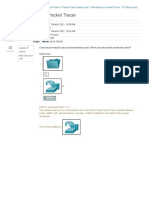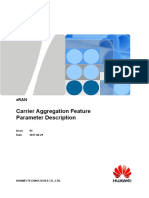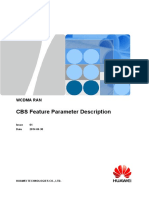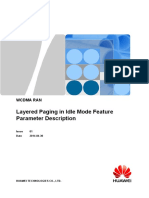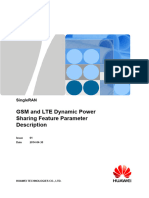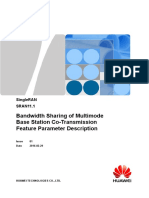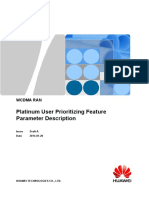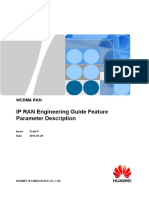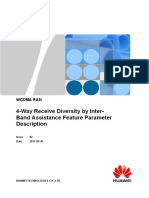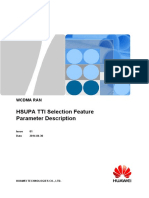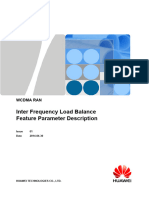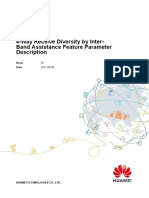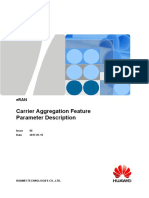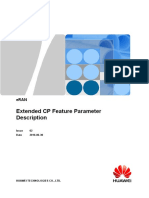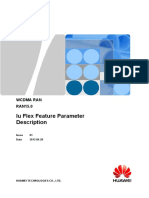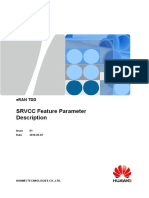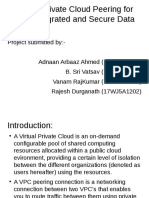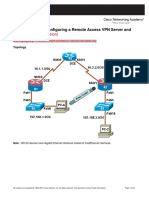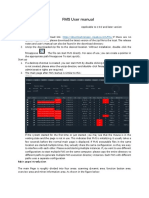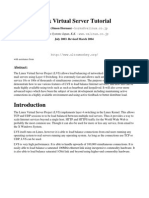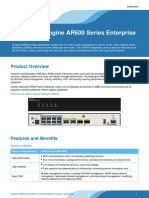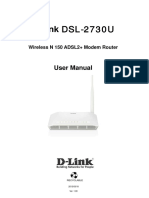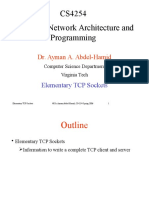CBS Feature Parameter Description: Wcdma Ran
CBS Feature Parameter Description: Wcdma Ran
Uploaded by
riamaCopyright:
Available Formats
CBS Feature Parameter Description: Wcdma Ran
CBS Feature Parameter Description: Wcdma Ran
Uploaded by
riamaOriginal Title
Copyright
Available Formats
Share this document
Did you find this document useful?
Is this content inappropriate?
Copyright:
Available Formats
CBS Feature Parameter Description: Wcdma Ran
CBS Feature Parameter Description: Wcdma Ran
Uploaded by
riamaCopyright:
Available Formats
WCDMA RAN
CBS Feature Parameter Description
Issue 01
Date 2014-04-30
HUAWEI TECHNOLOGIES CO., LTD.
Copyright © Huawei Technologies Co., Ltd. 2015. All rights reserved.
No part of this document may be reproduced or transmitted in any form or by any means without prior written
consent of Huawei Technologies Co., Ltd.
Trademarks and Permissions
and other Huawei trademarks are trademarks of Huawei Technologies Co., Ltd.
All other trademarks and trade names mentioned in this document are the property of their respective holders.
Notice
The purchased products, services and features are stipulated by the contract made between Huawei and the
customer. All or part of the products, services and features described in this document may not be within the
purchase scope or the usage scope. Unless otherwise specified in the contract, all statements, information,
and recommendations in this document are provided "AS IS" without warranties, guarantees or representations
of any kind, either express or implied.
The information in this document is subject to change without notice. Every effort has been made in the
preparation of this document to ensure accuracy of the contents, but all statements, information, and
recommendations in this document do not constitute a warranty of any kind, express or implied.
Huawei Technologies Co., Ltd.
Address: Huawei Industrial Base
Bantian, Longgang
Shenzhen 518129
People's Republic of China
Website: http://www.huawei.com
Email: support@huawei.com
Issue 01 (2014-04-30) Huawei Proprietary and Confidential i
Copyright © Huawei Technologies Co., Ltd.
WCDMA RAN
CBS Feature Parameter Description Contents
Contents
1 About This Document..................................................................................................................1
1.1 Scope..............................................................................................................................................................................1
1.2 Intended Audience..........................................................................................................................................................1
1.3 Change History...............................................................................................................................................................2
1.4 Differences Between Base Station Types.......................................................................................................................3
2 Overview.........................................................................................................................................4
3 Technical Description...................................................................................................................5
3.1 External CBC..................................................................................................................................................................6
3.1.1 System Architecture....................................................................................................................................................6
3.1.2 CBS Message Scheduling and Forwarding.................................................................................................................7
3.1.3 Network Topology with the Iu-BC Interface..............................................................................................................7
3.1.4 Signaling Protocols......................................................................................................................................................9
3.2 Built-in CBC.................................................................................................................................................................10
3.2.1 System Architecture..................................................................................................................................................10
3.2.2 CBS Message Scheduling and Forwarding...............................................................................................................11
3.2.3 Message Construction in the RNC............................................................................................................................11
3.2.4 Warning of Disaster...................................................................................................................................................11
4 Related Features...........................................................................................................................13
4.1 WRFD-011000 Cell Broadcast Service........................................................................................................................13
4.1.1 Prerequisite Features..................................................................................................................................................13
4.1.2 Mutually Exclusive Features.....................................................................................................................................13
4.1.3 Impacted Features......................................................................................................................................................13
4.2 WRFD-011001 Simplified Cell Broadcast...................................................................................................................13
4.2.1 Prerequisite Features..................................................................................................................................................13
4.2.2 Mutually Exclusive Features.....................................................................................................................................13
4.2.3 Impacted Features......................................................................................................................................................13
4.3 WRFD-020127 Warning of Disaster............................................................................................................................13
4.3.1 Prerequisite Features..................................................................................................................................................14
4.3.2 Mutually Exclusive Features.....................................................................................................................................14
4.3.3 Impacted Features......................................................................................................................................................14
5 Engineering Guidelines.............................................................................................................15
Issue 01 (2014-04-30) Huawei Proprietary and Confidential ii
Copyright © Huawei Technologies Co., Ltd.
WCDMA RAN
CBS Feature Parameter Description Contents
5.1 WRFD-011000 Cell Broadcast Service........................................................................................................................16
5.1.1 Deployment Requirements........................................................................................................................................16
5.1.2 Activation..................................................................................................................................................................16
5.1.3 Activation Observation..............................................................................................................................................20
5.1.4 Deactivation...............................................................................................................................................................25
5.2 WRFD-011001 Simplified Cell Broadcast...................................................................................................................26
5.2.1 Activation..................................................................................................................................................................26
5.2.2 Activation Observation..............................................................................................................................................28
5.2.3 Deactivation...............................................................................................................................................................29
5.2.4 Adjusting the CBS Configurations............................................................................................................................29
5.3 WRFD-020127 Warning of Disaster............................................................................................................................29
5.3.1 When to Use Warning of Disaster.............................................................................................................................29
5.3.2 Planning.....................................................................................................................................................................30
5.3.3 Feature Deployment..................................................................................................................................................30
5.3.4 Performance Monitoring............................................................................................................................................31
5.3.5 Parameter Optimization.............................................................................................................................................31
5.3.6 Troubleshooting.........................................................................................................................................................31
5.4 Enabling UE Battery Saving for CBS..........................................................................................................................32
5.4.1 Dynamically Turning On/Off the CTCH Indicator...................................................................................................32
5.4.2 Dynamically Adjusting the Length of Scheduling Messages....................................................................................32
6 Parameters.....................................................................................................................................33
7 Counters........................................................................................................................................46
8 Glossary.........................................................................................................................................47
9 Reference Documents.................................................................................................................48
Issue 01 (2014-04-30) Huawei Proprietary and Confidential iii
Copyright © Huawei Technologies Co., Ltd.
WCDMA RAN
CBS Feature Parameter Description 1 About This Document
1 About This Document
1.1 Scope
This document describes CBS, including its technical principles, related features, and
engineering guidelines. This document covers the following features:
l WRFD-011000 Cell Broadcast Service
l WRFD-011001 Simplified Cell Broadcast
l WRFD-020127 Warning of Disaster
This document applies to the following NE types.
NE Type NE Model
RNC BSC6900, BSC6910
NodeB Macro 3900 series macro base stations: BTS3900, BTS3900A,
BTS3900L, BTS3900AL, DBS3900, BTS3900C
3800 series macro base stations: DBS3800, BTS3812E,
BTS3812AE
Micro BTS3803E, BTS3902E
LampSite DBS3900 LampSite
1.2 Intended Audience
This document is intended for personnel who:
l Need to understand the features described herein
l Work with Huawei products
Issue 01 (2014-04-30) Huawei Proprietary and Confidential 1
Copyright © Huawei Technologies Co., Ltd.
WCDMA RAN
CBS Feature Parameter Description 1 About This Document
1.3 Change History
This section provides information about the changes in different document versions. There are
two types of changes, which are defined as follows:
l Feature change
Changes in features of a specific product version
l Editorial change
Changes in wording or addition of information that was not described in the earlier version
RAN16.0 01 (2014-04-30)
This issue does not include any changes.
RAN16.0 Draft A (2014-01-20)
Compared with Issue 01 (2013-04-28) of RAN15.0, Draft A (2014-01-20) of RAN16.0 includes
the following changes.
Change Type Change Description Parameter Change
Feature change Added the MML command Added the following
examples of configuring parameters:
licenses of the l CBSErl
WRFD-011000 Cell
Broadcast Service, l CBSkbps
WRFD-011001 Simplified l SimpCBSErl
Cell Broadcast feature, and l SimpCBSkbps
WRFD-020127 Warning of
l DisasterWarningErl
Disaster features for primary
and secondary operators. For l DisasterWarningkbps
details, see the following
sections:
5.1 WRFD-011000 Cell
Broadcast Service
5.2 WRFD-011001
Simplified Cell Broadcast
5.3 WRFD-020127
Warning of Disaster
Editorial change None None
Issue 01 (2014-04-30) Huawei Proprietary and Confidential 2
Copyright © Huawei Technologies Co., Ltd.
WCDMA RAN
CBS Feature Parameter Description 1 About This Document
1.4 Differences Between Base Station Types
Feature Support by Macro, Micro, and LampSite Base Stations
Feature Descripti Supported by Supporte Supported by Micro LampSit
ID on Controller(Y/N/NA) d by (Y/N/NA) e
Macro
BSC690 BSC691 (Y/N/ BTS380 BTS390
0 0 NA) 3E 2E
WRFD- Cell Y Y Y Y Y Y
011000 Broadca
st
Service
WRFD- Simplifi Y Y Y Y Y Y
011001 ed Cell
Broadca
st
WRFD- Warning Y Y Y Y Y Y
020127 of
Disaster
NOTE
Y indicates that a feature is supported; N indicates that a feature is not supported; NA indicates that an NE is
not involved, that is, a feature does not require the support of the NE.
The features described in this document are implemented in the same way on macro, micro, and
LampSite base stations.
Issue 01 (2014-04-30) Huawei Proprietary and Confidential 3
Copyright © Huawei Technologies Co., Ltd.
WCDMA RAN
CBS Feature Parameter Description 2 Overview
2 Overview
Cell broadcast service (CBS) provides a cell broadcast system that is supplemental to the existing
digital mobile communication platform. Through the cell broadcast system, the RNC sends
specific short messages to cells in a designated area, and consequently the cells broadcast the
messages to all the UEs supporting CBS within the coverage.
The CBS provides the point-to-multipoint service for 3G network users.
Messages broadcast using CBS are known as CBS messages. CBS-capable UEs constantly detect
CBS messages and notify users of the messages received.
The CBS has the following advantages:
l Compared with the point-to-point service, the CBS enables multiple UEs to receive the
same message, saving system resources.
l CBS service areas (SAs) map with physical cells in a one-on-one manner. This enables
CBS messages to be broadcast in designated areas.
To meet the customers' requirements efficiently, Huawei employs two types of cell broadcast
centers (CBCs) to implement the CBS, namely, external CBC and built-in CBC.
When the external CBC (WRFD-011000 Cell Broadcast Service) is used, it sends messages to
the RNC over the Iu-BC interface and then the RNC forwards the messages to UEs.
When the built-in CBC (WRFD-011001 Simplified Cell Broadcast) is used, the RNC housing
the built-in CBC constructs messages and delivers them to UEs.
Additionally, Huawei uses WRFD-020127 Warning of Disaster feature in built-in CBC scenario.
Warning of Disaster is an enhancement to WRFD-011001 Simplified Cell Broadcast. In the
absence of an external CBC, Warning of Disaster enables Huawei RNCs to deliver warning
notifications to all users served by the RNCs as quickly as possible. The RNCs support initiating,
modifying, and terminating warning notifications, and pre-designating target notification areas.
Maintenance personnel manually trigger warning notifications on the LMT or U2000, which are
then sent to the RNCs.
Issue 01 (2014-04-30) Huawei Proprietary and Confidential 4
Copyright © Huawei Technologies Co., Ltd.
WCDMA RAN
CBS Feature Parameter Description 3 Technical Description
3 Technical Description
The external CBC and built-in CBC are used in different scenarios to meet different demands
of customers. They cannot be used at the same time. The warning of disaster function is supported
by only the built-in CBC.
Issue 01 (2014-04-30) Huawei Proprietary and Confidential 5
Copyright © Huawei Technologies Co., Ltd.
WCDMA RAN
CBS Feature Parameter Description 3 Technical Description
3.1 External CBC
This section describes the system architecture, CBS message scheduling and forwarding,
network topology with the Iu-BC interface configured, signaling protocols.
3.1.1 System Architecture
The CBC, as a part of the core network (CN), is connected to multiple RNCs through the Iu-BC
interface. The CBC manages the CBS messages, whereas the UMTS radio access network
(UTRAN) performs transparent transmission of the CBS messages from the CBC.
A common traffic channel (CTCH) needs to be configured for each cell supporting the CBS
feature. The CTCH is mapped onto a FACH.
Figure 3-1 shows the system architecture when the external CBC is configured
Figure 3-1 System architecture when the external CBC is configured
CBC: cell broadcast center RNS: radio network subsystem
SAC: service area code UTRAN: UMTS radio access network
In the release of RAN14.0, the second CBC can be configured as a redundancy CBC for the
disaster preventing. Figure 3-2 shows the system architecture when the second external CBC
is configured.
Issue 01 (2014-04-30) Huawei Proprietary and Confidential 6
Copyright © Huawei Technologies Co., Ltd.
WCDMA RAN
CBS Feature Parameter Description 3 Technical Description
Figure 3-2 System architecture when the second external CBC is configured
CBC: cell broadcast center RNS: radio network subsystem
SAC: service area code UTRAN: UMTS radio access network
3.1.2 CBS Message Scheduling and Forwarding
When the external CBC is used, the CBS implementation procedure is as follows:
1. The external CBC sends a CBS message to the RNC over the Iu-BC interface. The message
contains service requirements such as the broadcast interval, broadcast times, and broadcast
area.
2. On receipt of the message, the RNC saves it to the buffer.
3. The RNC schedules and forwards the message based on the CTCH bandwidth allocated to
the Uu interface and the service requirements.
4. The UEs in CBS-capable cells receive CBS messages of the user-defined types.
UEs in idle mode or in the CELL_PCH or URA_PCH state can receive the CBS messages.
5. The RNC deletes the CBS messages from the buffer.
3.1.3 Network Topology with the Iu-BC Interface
The external CBC supports only Iu-BC over IP. Therefore, switching from TCP/IP to IP over
ATM (IPoA) must be performed if the ATM transmission mode is used on the Iu-BC interface.
Networking solutions are different in Iu-BC over IP mode and in Iu-BC over ATM mode.
Networking Solution in Iu-BC over IP Mode
Figure 3-3 shows the networking solution in Iu-BC over IP mode.
Issue 01 (2014-04-30) Huawei Proprietary and Confidential 7
Copyright © Huawei Technologies Co., Ltd.
WCDMA RAN
CBS Feature Parameter Description 3 Technical Description
Figure 3-3 Networking solution in Iu-BC over IP mode
CBE: cell broadcast entity
RNS: radio network subsystem
The advantage and disadvantage of this networking solution are as follows:
l Advantage
This networking solution provides flexible networking and simple configuration.
l Disadvantage
If the IP addresses of the RNC and CBC are on different network segments, a route needs
to be configured and extra routing devices need to be added. This leads to increase in the
cost.
Networking Solution in Iu-BC over ATM Mode
Figure 3-4 shows the networking solution in Iu-BC over ATM mode. In this mode, the ATM
switch implements the switching from the TCP/IP protocol stack to the IPoA protocol stack.
Issue 01 (2014-04-30) Huawei Proprietary and Confidential 8
Copyright © Huawei Technologies Co., Ltd.
WCDMA RAN
CBS Feature Parameter Description 3 Technical Description
Figure 3-4 Networking solution in Iu-BC over ATM mode
The advantage and disadvantage of this networking solution are as follows:
l Advantage
This solution is cost-effective because legacy ATM switches in the CN can be used and no
additional devices are required.
Legacy ATM switches in the CN can be used, therefore requiring no additional devices
and reducing the costs.
l Disadvantage
There are potential risks that the CN equipment of other vendors does not inter-operate
with Huawei external CBC.
3.1.4 Signaling Protocols
Figure 3-5 shows the protocol stack of CBS
Issue 01 (2014-04-30) Huawei Proprietary and Confidential 9
Copyright © Huawei Technologies Co., Ltd.
WCDMA RAN
CBS Feature Parameter Description 3 Technical Description
Figure 3-5 CBS protocol stack
The signaling procedures exchanged between CBC and RNC are listed as follows:
l Write-Replace procedure: used to broadcast new messages or replace the old messages.
l Kill procedure: used to stop the broadcasting of specific messages in specific cells.
l Load Status Inquiry procedure: CBC inquires the available bandwidth for message
broadcasting in specific cells.
l Message Status Inquiry procedure: inquiry of the CBS message status (number of
transmitting specific messages in a cell)
l Reset: stopping CBS service in specific cells
l Restart Indication: When cells resume and the CBS service is available again, the RNC
notifies the CN the cell status.
l Failure Indication: The RNC notifies the CN that CBS service in a cell fails.
For details, see 3GPP TS 23.041.
3.2 Built-in CBC
The CBC built in an RNC sends the cell name and messages to UEs on a regular basis. In addition
to the basic CBS function, Huawei built-in CBC also provides a disaster warning function. The
built-in CBC sends normal broadcast messages in normal situations and sends emergency
broadcast messages in emergencies.
3.2.1 System Architecture
When the built-in CBC is used, maintenance personnel can manually trigger CBS messages on
the LMT or U2000, and the messages are then sent to the RNC over the OMCH. The RNC
Issue 01 (2014-04-30) Huawei Proprietary and Confidential 10
Copyright © Huawei Technologies Co., Ltd.
WCDMA RAN
CBS Feature Parameter Description 3 Technical Description
broadcasts the received messages within designated cells. The messages can be broadcast
periodically.
Figure 3-6 shows the system architecture when the built-in CBC is configured.
Figure 3-6 System architecture when the built-in CBC is configured
3.2.2 CBS Message Scheduling and Forwarding
When the built-in CBC is used, the CBS implementation procedure is as follows:
1. The RNC constructs CBS messages in the same way as the CBS server and saves the
messages to the buffer.
2. The RNC schedules and forwards the message based on the CTCH bandwidth allocated to
the Uu interface and the service requirements.
3. The CBC forwards messages to UEs over the Uu interface. The UEs in CBS-capable cells
receive CBS messages of the user-defined types. UEs in idle, CELL_PCH, or URA_PCH
mode can receive CBS messages.
4. The RNC deletes the CBS messages from the buffer.
3.2.3 Message Construction in the RNC
In the built-in CBC case, the RNC needs to simulate functions of a CBS server by constructing
CBS messages. The following messages need to be constructed:
l Write-Replace message: This message is used to carry information. It is constructed and
sent by the RNC.
l KILL message: When the CBS function is disabled and the function is deactivated in the
cell, the RNC needs to send a KILL message to the cell to stop the cell broadcasting CBS
messages.
The RNC does not need to send the Write-Replace response message or the KILL response
message to the CN.
3.2.4 Warning of Disaster
This section describes the feature WRFD-020127 Warning of Disaster.
Issue 01 (2014-04-30) Huawei Proprietary and Confidential 11
Copyright © Huawei Technologies Co., Ltd.
WCDMA RAN
CBS Feature Parameter Description 3 Technical Description
The warning of disaster function is used to inform UEs in a designated area of disasters or
breaking events through broadcast. The purpose is to enable the subscribers to respond cautiously
to emergencies.
The warning of disaster function is supported by only the built-in CBC. When the function is
applied, the RNC constructs messages and delivers them to UEs in a designated area. The
designated area can be a single cell, multiple cells, or all cells under the RNC. The Warning of
Disaster feature does not require an external CBC.
Areas can be designated on a per RNC, location area, or cell basis. For details, see section 5.3.3
Feature Deployment
The warning of disaster function enables the network operators to compose emergency messages
on the O&M console when disasters (such as earthquake, tsunami, and hurricane) occur. Then,
the O&M console requests the RNC to send the emergency messages to all the UEs in the
designated area. The RNC sends the messages within four seconds after receiving the request.
Issue 01 (2014-04-30) Huawei Proprietary and Confidential 12
Copyright © Huawei Technologies Co., Ltd.
WCDMA RAN
CBS Feature Parameter Description 4 Related Features
4 Related Features
4.1 WRFD-011000 Cell Broadcast Service
4.1.1 Prerequisite Features
None
4.1.2 Mutually Exclusive Features
l WRFD-011001 Simplified Cell Broadcast
l WRFD-020127 Warning of Disaster
4.1.3 Impacted Features
None
4.2 WRFD-011001 Simplified Cell Broadcast
4.2.1 Prerequisite Features
None
4.2.2 Mutually Exclusive Features
l WRFD-011000 Cell Broadcast Service
4.2.3 Impacted Features
WRFD-020127 Warning of Disaster
4.3 WRFD-020127 Warning of Disaster
Issue 01 (2014-04-30) Huawei Proprietary and Confidential 13
Copyright © Huawei Technologies Co., Ltd.
WCDMA RAN
CBS Feature Parameter Description 4 Related Features
4.3.1 Prerequisite Features
WRFD-011001 Simplified Cell Broadcast
4.3.2 Mutually Exclusive Features
l WRFD-011000 Cell Broadcast Service
4.3.3 Impacted Features
None
Issue 01 (2014-04-30) Huawei Proprietary and Confidential 14
Copyright © Huawei Technologies Co., Ltd.
WCDMA RAN
CBS Feature Parameter Description 5 Engineering Guidelines
5 Engineering Guidelines
The following provides engineering guidelines regarding the configuration of CBS.
Issue 01 (2014-04-30) Huawei Proprietary and Confidential 15
Copyright © Huawei Technologies Co., Ltd.
WCDMA RAN
CBS Feature Parameter Description 5 Engineering Guidelines
5.1 WRFD-011000 Cell Broadcast Service
5.1.1 Deployment Requirements
The UE must meet the following requirements:
l CBS has been activated on the UE.
l Cell Broadcast Service has been activated on the UE.
l The Cell broadcast service license has been activated on the RNC side.
5.1.2 Activation
Using MML Commands
CBS Configuration in the Case of the External CBC
This section describes the CBS configuration procedure when the external CBC is used.
Activating the External CBC License
When the RNC uses the external CBC, the CBS license is required. To activate the CBS license,
perform the following steps:
Step 1 Obtain a new license file.
Step 2 Run the ACT LICENSE command on the U2000 or RNC LMT to activate the license file.
Step 3 Run the SET LICENSE command on RNC LMT to set the CBS license.
----End
Configuring the Iu-BC Interface
To configure the Iu-BC interface, you must configure related data according to the actual network
topology.
NOTE
The IP addresses on the Iu-BC interface can be shared. The device IP address of the Iu-BC interface board,
however, must be configured exclusively and cannot be shared.
Configuring CBS in Iu-BC over IP Mode
RNC Configuration
l Add an IP address of the Ethernet port.
– Run the RNC MML command ADD ETHIP to add the IP address of the Ethernet port.
– The IP address of the Ethernet port connected to the CBC and the IP address of the CBC
are recommended to be on the same network segment.
Issue 01 (2014-04-30) Huawei Proprietary and Confidential 16
Copyright © Huawei Technologies Co., Ltd.
WCDMA RAN
CBS Feature Parameter Description 5 Engineering Guidelines
l Add an IP route.
– Run the RNC MML command ADD IPRT to add a route from the interface board to
the CBC.
NOTE
If the IP address of the Ethernet port and the IP address of the CBC are on the same network segment, the
ADD IPRT command is not required.
l DSTIP(BSC6900,BSC6910): IP address of the CBC. You can query this IP address by
running the IPCONFIG command on a CBC local computer.
l NEXTHOP(BSC6900,BSC6910): IP address of the Ethernet port configured on the
interface board
l Add the device IP address of the interface board.
– Run the RNC MML command ADD DEVIP to add the device IP address of the interface
board.
– The IP address of the RNC interface board must be the same as the CBS IP address.
l Add the CBS configuration.
– Run the RNC MML command ADD UCBSADDR to add the TCP IP address used for
the SOCKET communication between the CBC and the RNC.
– RNCIPADDR(BSC6900,BSC6910): CBS IP address of the RNC
– CBCIPADDR(BSC6900,BSC6910): IP address of the CBC
NOTE
The subrack number and slot number do not need to be specified in the ADD UCBSADDR command on
the BSC6910. When the ADD UCBSADDR command is used for the BSC6900, the subrack number and
slot number are optional parameters.
Router Configuration
For details, see the associated router configuration document. The data must be negotiated with
the RNC.
CBC Configuration
Configure the IP address of the CBC and the route from the CBC to the RNC.
Configuring CBS in Iu-BC over ATM Mode
RNC Configuration
l Add the device IP address of the interface board.
Run the RNC MML command ADD DEVIP to add the device IP address of the interface
board. This device IP address and the IP address of the ATM switch must be on the same
network segment. The IP address of the RNC interface board must be the same as the CBS
IP address.
l Add an IPoA PVC to the ATM switch.
Run the RNC MML command ADD IPOAPVC to add an IPoA PVC between the local
IPoA client and the peer IPoA client.
Issue 01 (2014-04-30) Huawei Proprietary and Confidential 17
Copyright © Huawei Technologies Co., Ltd.
WCDMA RAN
CBS Feature Parameter Description 5 Engineering Guidelines
– IPADDR(BSC6900,BSC6910): IP address at the local end (that is, the IP address of the
interface board)
– PEERIPADDR(BSC6900,BSC6910): IP address of the ATM switch
– The local IP address and the peer IP address must be on the same subnet.
– The VPI and VCI must be the same as the settings of the ATM switch.
l Add an IP route.
Run the RNC MML command ADD IPRT to add a route from the interface board to the
CBC. The route passes an IP address of the ATM switch.
– DSTIP(BSC6900,BSC6910): IP address of the CBC. You can query this IP address by
running the IPCONFIG command on a CBC local computer.
– NEXTHOP(BSC6900,BSC6910): IP address of the ATM switch. By using this IP
address, the ATM switch exchanges information between the interface board and the
Ethernet port that is connected to the CBC.
l Add the CBS configuration.
Run the RNC MML command ADD UCBSADDR to add the CBS IP address of the RNC,
namely, the TCP IP address used for SOCKET communication between the CBC and the
RNC.
– RNCIPADDR(BSC6900,BSC6910): CBS IP address of the RNC
– CBCIPADDR(BSC6900,BSC6910): IP address of the CBC
ATM Switch Configuration
Set the IP address of the Ethernet port of the ATM switch and configure the IPoA client, IPoA
PVC, and IPoA route from the ATM switch to the RNC. The data must be negotiated with the
RNC. The VCI and VPI must be consistent with the settings of the RNC.
CBC Configuration
Configure the IP address of the CBC and the route from the CBC to the RNC.
Configuring CBS for a Cell at the Radio Network Layer
The CBS setup process consists of the following tasks:
1. Setting up a CTCH
2. Configuring the RLC for the CTCH
3. Configuring the Broadcast/Multicast Control (BMC)
4. Updating the system information on the Iub interface
5. Sending the RESTART IND message on the Iu-BC interface
When configuring CBS for a cell, ensure that the configurations of cell-level parameters in IP
mode and ATM mode are consistent. Figure 5-1 shows the procedure for configuring CBS for
a cell (at the radio network layer).
Issue 01 (2014-04-30) Huawei Proprietary and Confidential 18
Copyright © Huawei Technologies Co., Ltd.
WCDMA RAN
CBS Feature Parameter Description 5 Engineering Guidelines
Figure 5-1 Procedure for configuring CBS for a cell
The procedure for configuring CBS for a cell is as follows:
Step 1 Run the RNC MML command ADD UCTCH to add the CTCH for the cell supporting CBS.
NOTE
FACH ID is the unique identifier of an FACH in a cell. You need to negotiate the channel configuration
scheme with NodeB engineers according to the channel specifications supported by the NodeB.
Step 2 Run the RNC MML command ADD UCELLCBSDRX to set the CBS DRX scheduling
parameters for the cell supporting CBS.
NOTE
Generally, you can set the scheduling parameters to default values.
Step 3 Run the RNC MML command ADD UCELLCBSSAC to set the SAC that identifies the service
area (SA) for the cell supporting CBS.
NOTE
You can add a specific CBS cell to the CBS SA by setting the cell ID (CELLID).
CBS SAC identifies a CBS cell. The SAC is determined in network planning.
CBS SAs are different from CS/PS SAs. CBS SAs have a one-on-one mapping with physical cells.
CBS cannot be configured for two or more operators in a cell at the same time. In MOCN networks, it is
recommended that the CBS be configured for the primary operator or one of secondary operators.
Step 4 Run the RNC MML command ADD UCELLCBS to enable CBS in a cell. You can enable CBS
only after other radio network layer configurations are complete. After CBS is enabled, you can
Issue 01 (2014-04-30) Huawei Proprietary and Confidential 19
Copyright © Huawei Technologies Co., Ltd.
WCDMA RAN
CBS Feature Parameter Description 5 Engineering Guidelines
monitor the RESTART IND message on the Iu-BC interface and the CBS scheduling message
on the Uu interface.
----End
MML Command Examples
//Activating Cell Broadcast Service
//Configuring the CBS licenses for primary and secondary operators in networks
enabled with RAN Sharing and MOCN
SET LICENSE: SETOBJECT=UMTS, OperatorType=PRIM, CNOPERATORINDEX=1,
FeatureResAssignMode=ManualAssign,DisasterWarningErl=20000,DisasterWarningkbps=200
00000;
SET LICENSE: SETOBJECT=UMTS, OperatorType=SEC, CNOPERATORINDEX=1,
FeatureResAssignMode=ManualAssign, DisasterWarningErl=20000,
DisasterWarningkbps=20000000;
//Configuring the device IP address of the interface board
ADD DEVIP: SRN=5, SN=18, DEVTYPE=IPOA_CLIENT_IP, IPADDR="12.12.12.12",
MASK="255.255.255.0";
//Configuring the IPoA PVC
ADD IPOAPVC: IPADDR="12.12.12.12", PEERIPADDR="12.12.12.120", CARRYT=NCOPT,
CARRYNCOPTN=0, CARRYVPI=255, CARRYVCI=32, TXTRFX=103, RXTRFX=103, PEERT=OTHER;
//Configuring a route from the interface board to CBC
ADD IPRT: SRN=5, SN=18, DSTIP="11.11.11.12", DSTMASK="255.255.255.255",
NEXTHOP="12.12.12.120", PRIORITY=HIGH, REMARK="SGSN_CBS";
//Configuring the CBS socket IP address on BSC6900
ADD UCBSADDR: SRN=5, SN=2, CnOpIndex=1, RNCIPADDR="12.12.12.12",
CBCIPADDR="11.11.11.11", CBCMASK="255.255.255.0";
//Configuring the CBS socket IP address on BSC6910
ADD UCBSADDR: CnOpIndex=1, RNCIPADDR="12.12.12.12", CBCIPADDR="11.11.11.11",
CBCMASK="255.255.255.0";
//Configuring the CTCH for a cell
ADD UCTCH: CellId=0, FachId=4;
//Configuring the CBS DRX scheduling parameter
ADD UCELLCBSDRX: CellId=0;
//Configuring a CBS area
ADD UCELLCBSSAC: CellId=0, CnOpIndex=1, CBSSAC=0, MsgInd=OFF;
//Enabling the cell-level CBS
ACT UCELLCBS: CellId=0;
5.1.3 Activation Observation
Step 1 Check whether the CBS function works properly.
1. Ping the CBS IP address of the RNC on the CBC. If the ping operation is successful, it
indicates that the data transmission from CBC to RNC is normal.
2. Ping the CBC IP address on the RNC. The source IP address is the device IP address, that
is, the IP address of the CBS. PING IP: SRN=0, SN=16, SIPADDR="12.12.12.12",
DESTIP="11.11.11.11"; If the ping operation is successful, it indicates that the data
transmission from RNC to CBC is normal. If the ping operation fails, check the
configuration.
3. Check whether the CBS socket is connected properly. To do this, trace messages over the
Iu interface and view whether the SABP_LOAD_QUERY is sent to the RNC, as shown
in Figure 5-2
Issue 01 (2014-04-30) Huawei Proprietary and Confidential 20
Copyright © Huawei Technologies Co., Ltd.
WCDMA RAN
CBS Feature Parameter Description 5 Engineering Guidelines
Figure 5-2 Viewing the SABP_LOAD_QUERY message
4. As shown in 5.1.3 Activation Observation, the SABP_LOAD_QUERY_CMP message
returned from the RNC contains the information element (IE) available-bandwidth.
Figure 5-3 Viewing the SABP_LOAD_QUERY_CMP message
5. Run the RNC MML command DSP UCELL to check whether the CBS function works,
as shown in Figure 5-4.
Figure 5-4 Viewing the CBS function
Issue 01 (2014-04-30) Huawei Proprietary and Confidential 21
Copyright © Huawei Technologies Co., Ltd.
WCDMA RAN
CBS Feature Parameter Description 5 Engineering Guidelines
Step 2 Check the broadcast messages sent.
1. Use the MTC tool to send messages on the CBC. It is recommended that the time interval
for sending messages be within 10s and the number of messages sent be more than two (0
indicates infinity).
2. Trace messages transmitted over the Iu interface to check whether the
SABP_WRITE_REPLACE message has been sent to the RNC, as shown in Figure
5-5.
Figure 5-5 Viewing the SABP_WRITE_REPLACE message
As shown in Figure 5-6, the SABP_WRITE_REPLACE_CMP message returned from
the RNC contains a broadcast message with the IE number-of-broadcasts-completed.
Issue 01 (2014-04-30) Huawei Proprietary and Confidential 22
Copyright © Huawei Technologies Co., Ltd.
WCDMA RAN
CBS Feature Parameter Description 5 Engineering Guidelines
Figure 5-6 Viewing the SABP_WRITE_REPLACE_CMP message
3. Trace messages transmitted over the Uu interface to check whether the
UU_BMC_MSG_TYPE message beginning with 01 has been sent from the RNC, as
shown in Figure 5-7.
Figure 5-7 Viewing the UU_BMC_MSG_TYPE message
Step 3 Stop the RNC from sending broadcast messages.
----End
Issue 01 (2014-04-30) Huawei Proprietary and Confidential 23
Copyright © Huawei Technologies Co., Ltd.
WCDMA RAN
CBS Feature Parameter Description 5 Engineering Guidelines
1. On the CBC, select the message being sent and click delete.
2. Trace messages transmitted over the Iu interface to check whether the SABP_KILL
message has been sent to the RNC, as shown in Figure 5-8.
Figure 5-8 Viewing the SAB_KILL message
3. Trace messages transmitted over the Iu interface, as shown in Figure 5-9. The
SABP_KILL_CMP message returned from the RNC contains the IE number-of-
broadcast-completed.
Issue 01 (2014-04-30) Huawei Proprietary and Confidential 24
Copyright © Huawei Technologies Co., Ltd.
WCDMA RAN
CBS Feature Parameter Description 5 Engineering Guidelines
Figure 5-9 Viewing the SABP_KILL_CMP message
It can be viewed from the Uu interface trace data that the RNC stops sending the
UU_BMC_MSG_TYPE message beginning with 01.
5.1.4 Deactivation
Using MML Commands
Run the DEA UCELLCBS command to deactivate the CBS feature.
Deleting CBS Configurations in Iu-BC over IP Mode
To delete the CBS configurations in Iu-BC over IP mode, perform the following operations:
l Delete the configurations of the radio channels and parameters of the CBS by running the
following RNC MML commands:
– RMV UCTCH
– RMV UCELLCBSDRX
– RMV UCELLCBSSAC
l Delete the TCP IP address for SOCKET communication between the RNC and CBC by
running the following RNC MML command:
Issue 01 (2014-04-30) Huawei Proprietary and Confidential 25
Copyright © Huawei Technologies Co., Ltd.
WCDMA RAN
CBS Feature Parameter Description 5 Engineering Guidelines
– RMV UCBSADDR
l Delete the IP addresses of the Ethernet ports by running the following RNC MML
command:
– RMV ETHIP
l Delete the CBS IP address of the RNC by running the following RNC MML command:
– RMV DEVIP
l On the CBC, delete the IP address of the CBC and the route from the CBC to the RNC.
Deleting CBS Configurations in Iu-BC over ATM Mode
To delete the CBS configurations in Iu-BC over ATM mode, perform the following operations:
l Delete the configurations of the radio channels and parameters of the CBS by running the
following RNC MML commands:
– RMV UCTCH
– RMV UCELLCBSDRX
– RMV UCELLCBSSAC
l Delete the TCP IP address for SOCKET communication between the RNC and CBC by
running the following RNC MML command:
– RMV UCBSADDR
l Delete the IPoA client, IPoA PVC, and IPoA route from the RNC by running the following
RNC MML commands:
– RMV IPRT
– RMV IPOAPVC
l Delete the IPoA client and IPoA PVC from the ATM switch.
l From the ATM switch, delete the IP address of the Ethernet port that connects the ATM
switch and the CBC.
l On the CBC, delete the IP address of the CBC and the route from the CBC to the RNC.
MML Command Examples
//Deactivating Cell Broadcast Service
DEA UCELLCBS: CellId=0;
//Removing the CBS socket IP address
RMV UCBSADDR: CnOpIndex=1;
5.2 WRFD-011001 Simplified Cell Broadcast
5.2.1 Activation
Using MML Commands
Issue 01 (2014-04-30) Huawei Proprietary and Confidential 26
Copyright © Huawei Technologies Co., Ltd.
WCDMA RAN
CBS Feature Parameter Description 5 Engineering Guidelines
Activating the Built-in CBC License
When the RNC uses the built-in CBC, the license for Simplified Cell Broadcast is required. That
is, you must apply for and activate the Simplified Cell Broadcast license before using Simplified
Cell Broadcast.
Configuring CBS
Adding CBS Configurations for Broadcast Messages
To add CBS configurations for broadcast messages, perform the following operations:
Step 1 Set the IP address and associated parameters of the built-in CBC.
l Run the RNC MML command ADD URNCCBCPUID command to configure the
subsystem for managing the built-in CBC.
NOTE
The subrack number, slot number, and subsystem number do not need to be specified in the ADD
URNCCBCPUID command on the BSC6910. When the ADD URNCCBCPUID command is used for
the BSC6900, the subrack number and slot number are optional parameters.
l Run the RNC MML command SET URNCCBPARA command with CBSwitch
(BSC6900,BSC6910) set to ON(ON) to enable the CBS function.
Step 2 Configure radio channels and parameters for the CBS
l Run the RNC MML command ADD UCTCH command to add the CTCH.
l Run the RNC MML command ADD UCELLCBSDRX command to set the CBS DRX
scheduling parameters.
l Run the RNC MML command ADD UCELLCBSSAC command to add CBS SAs and cell
broadcast contents.
NOTE
You can run the RNC MML command MOD UCELLCBSSAC to modify the CBS SAs and cell broadcast
contents as required.
Step 3 Activate the CBS by running the RNC MML command ACT UCELLCBS.
----End
Deleting CBS Configurations for Broadcast Messages
To delete the built-in CBC configurations for broadcast messages, perform the following
operations:
Step 1 Delete the configurations of the CBS radio network layer channels and parameters by running
the following RNC MML commands:
l RMV UCTCH
l RMV UCELLCBSDRX
l RMV UCELLCBSSAC
Step 2 Run the RNC MML command RMV URNCCBCPUID to delete the configuration of the
subsystem for managing the built-in CBC.
Issue 01 (2014-04-30) Huawei Proprietary and Confidential 27
Copyright © Huawei Technologies Co., Ltd.
WCDMA RAN
CBS Feature Parameter Description 5 Engineering Guidelines
Step 3 Run the RNC MML command SET URNCCBPARA with CBSwitch(BSC6900,BSC6910) set
to OFF(OFF) to disable the CBS.
----End
MML Command Examples
//Activating Simplified Cell Broadcast
//Configuring the licenses of Simplified Cell Broadcast for primary and secondary
operators in networks enabled with RAN Sharing and MOCN
SET LICENSE: SETOBJECT=UMTS, OperatorType=PRIM, CNOPERATORINDEX=1,
FeatureResAssignMode=ManualAssign, SimpCBSErl=20000, SimpCBSkbps=20000000;
SET LICENSE: SETOBJECT=UMTS, OperatorType=SEC, CNOPERATORINDEX=1,
FeatureResAssignMode=ManualAssign, SimpCBSErl=20000, SimpCBSkbps=20000000;
//Configuring the SPU subsystem of the built-in CBC on BSC6900
ADD URNCCBCPUID: CnOpIndex=1, SRN=0, SN=2, SSN=1;
// Configuring the SPU subsystem of the built-in CBC on BSC6910
ADD URNCCBCPUID: CnOpIndex=1;
//Enabling the built-in CBC for the RNC
SET URNCCBPARA: CBSwitch=ON, RepeatPeriod=10, RepeatNum=0;
//Configuring the CTCH for a cell
ADD UCTCH: CellId=0, FachId=4;
//Configuring the CBS DRX scheduling parameter
ADD UCELLCBSDRX: CellId=0;
//Configuring a CBS area and a broadcast message
ADD UCELLCBSSAC: CellId=0, CnOpIndex=1, CBSSAC=0, MsgInd=ON, MsgContent="welcome!
it is cell 0";
//Enabling the CBS function for a cell
ACT UCELLCBS: CellId=0;
//Activating the CBS function for a cell
ACT UCELLCBS: CellId=0;
5.2.2 Activation Observation
Step 1 Check whether the CBS function works properly.
After activating CBS on the RNC, if the UU_BMC_MSG_TYPE message beginning with 01
is detected over the Uu interface, as shown in Figure 5-10, the CBS feature works properly.
Figure 5-10 UU_BMC_MSG_TYPE message
Step 2 Use a test UE to camp on a designated cell, and check whether the test UE can receive CBS
warning notifications.
----End
Issue 01 (2014-04-30) Huawei Proprietary and Confidential 28
Copyright © Huawei Technologies Co., Ltd.
WCDMA RAN
CBS Feature Parameter Description 5 Engineering Guidelines
5.2.3 Deactivation
Using MML Commands
To deactivate the CBS function of a single cell, run the RNC MML command DEA
UCELLCBS.
To deactivate the CBS function of the entire RNC, run the RNC MML command SET
URNCCBPARA command to disable the CBS function of the RNC.
MML Command Examples
//Deactivating Simplified Cell Broadcast
//Disabling the CBS function for a cell
DEA UCELLCBS: CellId=0;
//Disabling the CBS function for the BSC6900
SET URNCCBPARA: CBSwitch=OFF;
5.2.4 Adjusting the CBS Configurations
Table 5-1 lists the MML commands used for reconfiguring the built-in CBC. For details, see
the MML command online help.
Table 5-1 MML commands for reconfiguring the built-in CBC
Operation Command
For the built-in CBC Set broadcast parameters for SET URNCCBPARA
broadcast parameters the built-in CBC
For the information about the Add the information about ADD UCTCH
CTCH of a cell the CTCH of a cell
Modify the information MOD UCTCH
about the CTCH of a cell
Delete the information about RMV UCTCH
the CTCH of a cell
For the CBS SAs and Add CBS SAs and broadcast ADD CELLCBSSAC
broadcast message message
Modify the CBS SA MOD CELLCBSSAC
Delete the CBS SA RMV CELLCBSSAC
5.3 WRFD-020127 Warning of Disaster
5.3.1 When to Use Warning of Disaster
In the absence of an external CBC, you are advised to use the Warning of Disaster feature to
send warning notifications about natural disasters (such as earthquakes and tsunamis) to mobile
Issue 01 (2014-04-30) Huawei Proprietary and Confidential 29
Copyright © Huawei Technologies Co., Ltd.
WCDMA RAN
CBS Feature Parameter Description 5 Engineering Guidelines
users as quickly as possible. As an enhancement to WRFD-011001 Simplified Cell Broadcast,
Warning of Disaster helps to better safeguard lives and property.
5.3.2 Planning
The Warning of Disaster feature does not require an external CBC.
5.3.3 Feature Deployment
Activation
Using MML Commands
Before you activate Warning of Disaster, ensure that Simplified Cell Broadcast has been
activated and the CBS is functioning normally in associated cells.
To activate Warning of Disaster, perform the following steps:
Step 1 Activate the feature license.
Step 2 Run the RNC MML command SET URNCCBPARA with CB Switch and CTCH switch of
cell broadcast both set to ON(ON).
Step 3 Run the RNC MML command ADD UCBSAREA to set parameters for the designated
notification areas.
Step 4 Run the RNC MML command ADD UCBSMSG to set parameters for cell broadcast messages.
----End
MML Command Examples
//Activating Warning of Disaster for a specific cell
//Configuring the licenses of Warning of Disaster for primary and secondary
operators in networks enabled with RAN Sharing and MOCN
SET LICENSE: SETOBJECT=UMTS, OperatorType=PRIM, CNOPERATORINDEX=1,
FeatureResAssignMode=ManualAssign,DisasterWarningErl=20000,DisasterWarningkbps=200
00000;
SET LICENSE: SETOBJECT=UMTS, OperatorType=SEC, CNOPERATORINDEX=1,
FeatureResAssignMode=ManualAssign, DisasterWarningErl=20000,
DisasterWarningkbps=20000000;
SET URNCCBPARA: CBSwitch=ON, CTCHSwitch =ON;
ADD UCBSAREA: AreaId=1, CnOpIndex=1, AreaType=CELL, CellId=22;
ADD UCBSMSG: MsgIndex=0, MsgTypeId=1, GeographicalScope=CellImmediate,
Priority=High, RepetPeriod=10, NumOfBrdcstReq=5, CodeType=English, AreaID=1,
EmergencyType=Other, CBSMsg="Hurricane";
Activation Observation
To verify whether the feature has been activated, use a test UE to camp on a designated cell, and
check whether the test UE can receive CBS warning notifications.
Deactivation
Issue 01 (2014-04-30) Huawei Proprietary and Confidential 30
Copyright © Huawei Technologies Co., Ltd.
WCDMA RAN
CBS Feature Parameter Description 5 Engineering Guidelines
Using MML Commands
To deactivate Warning of Disaster, perform the following steps:
Step 1 Deactivate the feature license.
Step 2 Delete the configurations for Warning of Disaster.
----End
1. Run the RNC MML command RMV UCBSMSG to delete CBS warning notifications.
2. Run the RNC MML command RMV UCBSAREA to delete the designated broadcast areas.
3. Run the RNC MML command SET URNCCBPARA with CTCH switch of cell
broadcast set to OFF(OFF) to disable the Warning of Disaster feature.
MML Command Examples
//Deactivating Warning of Disaster
ADD UCBSMSG: MsgIndex=0;
ADD UCBSAREA: AreaId=1, AreaType=CELL, CellId=22; SET URNCCBPARA: CTCHSwitch=OFF;
5.3.4 Performance Monitoring
None
5.3.5 Parameter Optimization
Table 5-2 lists the MML commands used to adjust Warning of Disaster parameter settings. For
details, see MML Command Reference.
Table 5-2 MML commands used to adjust Warning of Disaster parameter settings
Operation Command
For the built-in CBC Set broadcast parameters for SET URNCCBPARA
broadcast parameters the built-in CBC
For CBS SAs Query CBS SAs LST UCBSAREA
Add CBS SAs ADD UCBSAREA
Delete CBS SAs RMV UCBSAREA
For warning notifications Add warning notifications ADD UCBSMSG
Modify warning MOD UCBSMSG
notifications
Delete warning notifications RMV UCBSMSG
Query warning notifications DSP UCBSMSG
5.3.6 Troubleshooting
None
Issue 01 (2014-04-30) Huawei Proprietary and Confidential 31
Copyright © Huawei Technologies Co., Ltd.
WCDMA RAN
CBS Feature Parameter Description 5 Engineering Guidelines
5.4 Enabling UE Battery Saving for CBS
After CBS is activated, UEs monitor the CTCH even when no CBS messages are sent, increasing
battery consumption of UEs. Two methods for UE battery saving were available, which are
described as follows:
l Dynamically turning on/off the CTCH indicator
When no CBS messages are sent at the current scheduling moment, the CTCH indicator is
turned off by default in system information block 5 (SIB5). The RNC sends the system
information to turn on the CTCH indicator if a CBS message is to be sent.
The turned-on CTCH indicator will be turned off if no CBS messages are sent during a
certain period.
l Dynamically adjusting the length of scheduling messages
If no CBS messages are sent at the current scheduling moment, the RNC reduces the length
of scheduling messages; if a CBS message is to be sent at the current scheduling moment,
the RNC extends the length of scheduling messages.
NOTE
Using the methods for UE battery saving increases the transmission delay of CBS messages. It is good
practice to disable UE battery saving for Warning of Disaster.
5.4.1 Dynamically Turning On/Off the CTCH Indicator
Run the RNC MML command ADD UCELLCBSDRX command with
CTCH_DYN_CTRL_SWITCH selected in the CbsEnhanceSwitch(BSC6900,BSC6910)
parameter.
5.4.2 Dynamically Adjusting the Length of Scheduling Messages
Step 1 Run the RNC MML command DEA UCELLCBS to deactivate the CBS function for a cell.
Step 2 Run the RNC MML command ADD UCELLCBSDRX with
CBS_SCHBLOCK_DYN_ADJ_SWITCH selected in the CbsEnhanceSwitch
(BSC6900,BSC6910) parameter.
Step 3 Run the RNC MML command ACT UCELLCBS to activate the CBS function for a cell.
----End
Issue 01 (2014-04-30) Huawei Proprietary and Confidential 32
Copyright © Huawei Technologies Co., Ltd.
WCDMA RAN
CBS Feature Parameter Description 6 Parameters
6 Parameters
Table 6-1 Parameter description
Parameter ID NE MML Feature ID Feature Name Description
Command
DSTIP BSC6900 ADD IPRT WRFD-050402 IP Transmission Meaning:Destin
MOD IPRT WRFD-050409 Introduction on ation IP address.
Iub Interface GUI Value
RMV IPRT WRFD-050410
IP Transmission Range:Valid IP
Introduction on Address
Iu Interface Unit:None
IP Transmission Actual Value
Introduction on Range:Valid IP
Iur Interface Address
Default
Value:None
DSTIP BSC6910 ADD IPRT WRFD-150243 Iub IP Meaning:Destin
MOD IPRT WRFD-150244 Transmission ation IP address.
Based on GUI Value
RMV IPRT Dynamic Load Range:Valid IP
Balance Address
Iu/Iur IP Unit:None
Transmission
Based on Actual Value
Dynamic Load Range:Valid IP
Balance Address
Default
Value:None
Issue 01 (2014-04-30) Huawei Proprietary and Confidential 33
Copyright © Huawei Technologies Co., Ltd.
WCDMA RAN
CBS Feature Parameter Description 6 Parameters
Parameter ID NE MML Feature ID Feature Name Description
Command
NEXTHOP BSC6900 ADD IPRT WRFD-050107 IP routing Based Meaning:IP
MOD IPRT WRFD-050402 Hub Node B address of the
IP Transmission next hop.
RMV IPRT WRFD-050409
Introduction on GUI Value
WRFD-050410 Iub Interface Range:Valid IP
IP Transmission Address
Introduction on Unit:None
Iu Interface Actual Value
IP Transmission Range:Valid IP
Introduction on Address
Iur Interface Default
Value:None
NEXTHOP BSC6910 ADD IPRT WRFD-050107 IP routing Based Meaning:IP
MOD IPRT WRFD-150243 Hub Node B address of the
Iub IP next hop.
RMV IPRT WRFD-150244
Transmission GUI Value
Based on Range:Valid IP
Dynamic Load Address
Balance Unit:None
Iu/Iur IP Actual Value
Transmission Range:Valid IP
Based on Address
Dynamic Load
Balance Default
Value:None
RNCIPADDR BSC6900 ADD WRFD-011000 Cell Broadcast Meaning:IP
UCBSADDR Service address of the
MOD RNC.
UCBSADDR GUI Value
Range:Valid IP
Address
Unit:None
Actual Value
Range:Valid IP
Address
Default
Value:None
Issue 01 (2014-04-30) Huawei Proprietary and Confidential 34
Copyright © Huawei Technologies Co., Ltd.
WCDMA RAN
CBS Feature Parameter Description 6 Parameters
Parameter ID NE MML Feature ID Feature Name Description
Command
RNCIPADDR BSC6910 ADD WRFD-011000 Cell Broadcast Meaning:IP
UCBSADDR Service address of the
MOD RNC.
UCBSADDR GUI Value
Range:Valid IP
Address
Unit:None
Actual Value
Range:Valid IP
Address
Default
Value:None
CBCIPADDR BSC6900 ADD WRFD-011000 Cell Broadcast Meaning:IP
UCBSADDR Service address of the
MOD CBC (Cell
UCBSADDR Broadcast
Center).
GUI Value
Range:Valid IP
Address
Unit:None
Actual Value
Range:Valid IP
Address
Default
Value:None
CBCIPADDR BSC6910 ADD WRFD-011000 Cell Broadcast Meaning:IP
UCBSADDR Service address of the
MOD CBC (Cell
UCBSADDR Broadcast
Center).
GUI Value
Range:Valid IP
Address
Unit:None
Actual Value
Range:Valid IP
Address
Default
Value:None
Issue 01 (2014-04-30) Huawei Proprietary and Confidential 35
Copyright © Huawei Technologies Co., Ltd.
WCDMA RAN
CBS Feature Parameter Description 6 Parameters
Parameter ID NE MML Feature ID Feature Name Description
Command
IPADDR BSC6900 ADD IPOAPVC WRFD-031100 BOOTP Meaning:Local
MOD WRFD-050301 Permanent IP address
IPOAPVC 05 AAL5 GUI Value
RMV WRFD-050301 Connections for Range:Valid IP
IPOAPVC Control Plane Address
WRFD-050105 Traffic Unit:None
ATM Actual Value
Transmission Range:Valid IP
Introduction Address
Package
Default
ATM Switching Value:None
Based Hub
Node B
IPADDR BSC6910 ADD IPOAPVC WRFD-031100 BOOTP Meaning:Local
MOD WRFD-050301 Permanent IP address
IPOAPVC 05 AAL5 GUI Value
RMV WRFD-050301 Connections for Range:Valid IP
IPOAPVC Control Plane Address
WRFD-050105 Traffic Unit:None
ATM Actual Value
Transmission Range:Valid IP
Introduction Address
Package
Default
ATM Switching Value:None
Based Hub
Node B
PEERIPADDR BSC6900 ADD IPOAPVC WRFD-031100 BOOTP Meaning:Peer
MOD WRFD-050301 Permanent IP address.
IPOAPVC 05 AAL5 GUI Value
RMV WRFD-050301 Connections for Range:Valid IP
IPOAPVC Control Plane Address
WRFD-050105 Traffic Unit:None
ATM Actual Value
Transmission Range:Valid IP
Introduction Address
Package
Default
ATM Switching Value:None
Based Hub
Node B
Issue 01 (2014-04-30) Huawei Proprietary and Confidential 36
Copyright © Huawei Technologies Co., Ltd.
WCDMA RAN
CBS Feature Parameter Description 6 Parameters
Parameter ID NE MML Feature ID Feature Name Description
Command
PEERIPADDR BSC6910 ADD IPOAPVC WRFD-031100 BOOTP Meaning:Peer
MOD WRFD-050301 Permanent IP address.
IPOAPVC 05 AAL5 GUI Value
RMV WRFD-050301 Connections for Range:Valid IP
IPOAPVC Control Plane Address
WRFD-050105 Traffic Unit:None
ATM Actual Value
Transmission Range:Valid IP
Introduction Address
Package
Default
ATM Switching Value:None
Based Hub
Node B
CBSwitch BSC6900 SET WRFD-011001 Simplified Cell Meaning:switch
URNCCBPAR Broadcast of the inner CBS
A function.
GUI Value
Range:OFF
(OFF), ON(ON)
Unit:None
Actual Value
Range:OFF, ON
Default
Value:OFF
(OFF)
CBSwitch BSC6910 SET WRFD-011001 Simplified Cell Meaning:switch
URNCCBPAR Broadcast of the inner CBS
A function.
GUI Value
Range:OFF
(OFF), ON(ON)
Unit:None
Actual Value
Range:OFF, ON
Default
Value:OFF
(OFF)
Issue 01 (2014-04-30) Huawei Proprietary and Confidential 37
Copyright © Huawei Technologies Co., Ltd.
WCDMA RAN
CBS Feature Parameter Description 6 Parameters
Parameter ID NE MML Feature ID Feature Name Description
Command
CbsEnhanceSwi BSC6900 ADD WRFD-011000 Cell Broadcast Meaning:1.
tch UCELLCBSDR Service CTCH_DYN_C
X TRL_SWITCH:
MOD Whether to
UCELLCBSDR enable the
X dynamic CTCH
indicator
function. ON:
This switch is
turned on. The
dynamic CTCH
indicator
function is
enabled. After
the CBS
function is
enabled and the
RNC turns on
the CTCH
indicator in
SIB5, the RNC
turns off the
CTCH indicator
in SIB5 if no
CBS message
was broadcast in
the last 10
minutes. The
RNC does not
turn on the
CTCH indicator
in SIB5 until
CBS messages
need to be
broadcast. OFF:
This switch is
turned off. The
dynamic CTCH
indicator
function is
disabled. 2.
CBS_SCHBLO
CK_DYN_ADJ
_SWITCH:
Whether to
enable dynamic
adjustment of
cell broadcast
Issue 01 (2014-04-30) Huawei Proprietary and Confidential 38
Copyright © Huawei Technologies Co., Ltd.
WCDMA RAN
CBS Feature Parameter Description 6 Parameters
Parameter ID NE MML Feature ID Feature Name Description
Command
service (CBS)
scheduling
messages when
the CBS feature
is enabled. ON:
This switch is
turned on.
Dynamic
adjustment of
CBS scheduling
messages is
enabled. If no
CBS message
needs to be
broadcast in the
current
scheduling
period, the RNC
reduces the
length of CBS
scheduling
messages so that
CBS scheduling
messages of the
next scheduling
period can be
broadcast. In
addition, the
RNC sets
Message
Description
Type that
corresponds to
the value of the
RsvdCbsCapaci
ty parameter to
no message in
CBS scheduling
messages. If
CBS messages
need to be
broadcast in the
current
scheduling
period, the RNC
adjusts the
length of CBS
scheduling
Issue 01 (2014-04-30) Huawei Proprietary and Confidential 39
Copyright © Huawei Technologies Co., Ltd.
WCDMA RAN
CBS Feature Parameter Description 6 Parameters
Parameter ID NE MML Feature ID Feature Name Description
Command
messages based
on the value of
RsvdBsCapacit
y parameter and
sets Message
Description
Type that
corresponds to
the value of the
RsvdCbsCapaci
ty parameter to
Reading advised
in CBS
scheduling
messages. The
RNC configures
scheduling
information
about CBS
messages in
CBS scheduling
messages of the
next scheduling
period. OFF:
This switch is
turned off.
Dynamic
adjustment of
CBS scheduling
messages is
disabled. The
RNC sets the
length of
scheduling
messages based
on the value of
the
RsvdBsCapacit
y parameter and
sets Message
Description
Type that
corresponds to
the value of the
RsvdCbsCapaci
ty parameter to
Reading advised
in CBS
Issue 01 (2014-04-30) Huawei Proprietary and Confidential 40
Copyright © Huawei Technologies Co., Ltd.
WCDMA RAN
CBS Feature Parameter Description 6 Parameters
Parameter ID NE MML Feature ID Feature Name Description
Command
scheduling
messages.
Modifications to
this switch take
effect for an
active CBS cell
only after the
CBS has been
deactivated and
then reactivated
in the CBS cell.
GUI Value
Range:CTCH_
DYN_CTRL_S
WITCH,
CBS_SCHBLO
CK_DYN_ADJ
_SWITCH
Unit:None
Actual Value
Range:CTCH_
DYN_CTRL_S
WITCH,
CBS_SCHBLO
CK_DYN_ADJ
_SWITCH
Default
Value:CTCH_D
YN_CTRL_SW
ITCH-0&CBS_
SCHBLOCK_D
YN_ADJ_SWI
TCH-0
Issue 01 (2014-04-30) Huawei Proprietary and Confidential 41
Copyright © Huawei Technologies Co., Ltd.
WCDMA RAN
CBS Feature Parameter Description 6 Parameters
Parameter ID NE MML Feature ID Feature Name Description
Command
CbsEnhanceSwi BSC6910 ADD WRFD-011000 Cell Broadcast Meaning:1.
tch UCELLCBSDR Service CTCH_DYN_C
X TRL_SWITCH:
MOD Whether to
UCELLCBSDR enable the
X dynamic CTCH
indicator
function. ON:
This switch is
turned on. The
dynamic CTCH
indicator
function is
enabled. After
the CBS
function is
enabled and the
RNC turns on
the CTCH
indicator in
SIB5, the RNC
turns off the
CTCH indicator
in SIB5 if no
CBS message
was broadcast in
the last 10
minutes. The
RNC does not
turn on the
CTCH indicator
in SIB5 until
CBS messages
need to be
broadcast. OFF:
This switch is
turned off. The
dynamic CTCH
indicator
function is
disabled. 2.
CBS_SCHBLO
CK_DYN_ADJ
_SWITCH:
Whether to
enable dynamic
adjustment of
cell broadcast
Issue 01 (2014-04-30) Huawei Proprietary and Confidential 42
Copyright © Huawei Technologies Co., Ltd.
WCDMA RAN
CBS Feature Parameter Description 6 Parameters
Parameter ID NE MML Feature ID Feature Name Description
Command
service (CBS)
scheduling
messages when
the CBS feature
is enabled. ON:
This switch is
turned on.
Dynamic
adjustment of
CBS scheduling
messages is
enabled. If no
CBS message
needs to be
broadcast in the
current
scheduling
period, the RNC
reduces the
length of CBS
scheduling
messages so that
CBS scheduling
messages of the
next scheduling
period can be
broadcast. In
addition, the
RNC sets
Message
Description
Type that
corresponds to
the value of the
RsvdCbsCapaci
ty parameter to
no message in
CBS scheduling
messages. If
CBS messages
need to be
broadcast in the
current
scheduling
period, the RNC
adjusts the
length of CBS
scheduling
Issue 01 (2014-04-30) Huawei Proprietary and Confidential 43
Copyright © Huawei Technologies Co., Ltd.
WCDMA RAN
CBS Feature Parameter Description 6 Parameters
Parameter ID NE MML Feature ID Feature Name Description
Command
messages based
on the value of
RsvdBsCapacit
y parameter and
sets Message
Description
Type that
corresponds to
the value of the
RsvdCbsCapaci
ty parameter to
Reading advised
in CBS
scheduling
messages. The
RNC configures
scheduling
information
about CBS
messages in
CBS scheduling
messages of the
next scheduling
period. OFF:
This switch is
turned off.
Dynamic
adjustment of
CBS scheduling
messages is
disabled. The
RNC sets the
length of
scheduling
messages based
on the value of
the
RsvdBsCapacit
y parameter and
sets Message
Description
Type that
corresponds to
the value of the
RsvdCbsCapaci
ty parameter to
Reading advised
in CBS
Issue 01 (2014-04-30) Huawei Proprietary and Confidential 44
Copyright © Huawei Technologies Co., Ltd.
WCDMA RAN
CBS Feature Parameter Description 6 Parameters
Parameter ID NE MML Feature ID Feature Name Description
Command
scheduling
messages.
Modifications to
this switch take
effect for an
active CBS cell
only after the
CBS has been
deactivated and
then reactivated
in the CBS cell.
GUI Value
Range:CTCH_
DYN_CTRL_S
WITCH,
CBS_SCHBLO
CK_DYN_ADJ
_SWITCH
Unit:None
Actual Value
Range:CTCH_
DYN_CTRL_S
WITCH,
CBS_SCHBLO
CK_DYN_ADJ
_SWITCH
Default
Value:CTCH_D
YN_CTRL_SW
ITCH-0&CBS_
SCHBLOCK_D
YN_ADJ_SWI
TCH-0
Issue 01 (2014-04-30) Huawei Proprietary and Confidential 45
Copyright © Huawei Technologies Co., Ltd.
WCDMA RAN
CBS Feature Parameter Description 7 Counters
7 Counters
There are no specific counters associated with this feature.
Issue 01 (2014-04-30) Huawei Proprietary and Confidential 46
Copyright © Huawei Technologies Co., Ltd.
WCDMA RAN
CBS Feature Parameter Description 8 Glossary
8 Glossary
For the acronyms, abbreviations, terms, and definitions, see Glossary.
Issue 01 (2014-04-30) Huawei Proprietary and Confidential 47
Copyright © Huawei Technologies Co., Ltd.
WCDMA RAN
CBS Feature Parameter Description 9 Reference Documents
9 Reference Documents
1. 3GPP TS 25.324, "Broadcast/Multicast Control (BMC)"
2. 3GPP TS 25.419, "UTRAN Iu-BC Interface: Service Area Broadcast Protocol (SABP)"
Issue 01 (2014-04-30) Huawei Proprietary and Confidential 48
Copyright © Huawei Technologies Co., Ltd.
You might also like
- Cisco Packet Tracer - ReviewDocument9 pagesCisco Packet Tracer - ReviewLiliana0% (1)
- Moshell ASM ScriptDocument20 pagesMoshell ASM Scriptriama0% (1)
- DRX and Signaling Control (eRAN12.1 - 03) PDFDocument189 pagesDRX and Signaling Control (eRAN12.1 - 03) PDFKhin Nyein ThuNo ratings yet
- Carrier AggregationDocument994 pagesCarrier Aggregationaman_sn50% (4)
- UMTS PagingDocument51 pagesUMTS PagingriamaNo ratings yet
- CBS Feature Parameter Description: Wcdma RanDocument56 pagesCBS Feature Parameter Description: Wcdma RanKhutso Raul MokateNo ratings yet
- CBS Feature Parameter Description: Wcdma RanDocument52 pagesCBS Feature Parameter Description: Wcdma RanyenvidoanNo ratings yet
- Mc-Hsdpa (Ran16.0 01)Document179 pagesMc-Hsdpa (Ran16.0 01)yenvidoanNo ratings yet
- Layered Paging in Idle Mode (RAN16.0 - 01)Document52 pagesLayered Paging in Idle Mode (RAN16.0 - 01)jaxcom4578No ratings yet
- Uplink 16QAM+E-DPCCH Boosting (RAN16.0 - 01)Document78 pagesUplink 16QAM+E-DPCCH Boosting (RAN16.0 - 01)Dost MuhammadNo ratings yet
- Multi-Carrier HSDPA (RAN17.1 02)Document247 pagesMulti-Carrier HSDPA (RAN17.1 02)riamaNo ratings yet
- CBS (RAN16.0 - Draft A)Document51 pagesCBS (RAN16.0 - Draft A)Sam FicherNo ratings yet
- GSM and LTE Dynamic Power Sharing (SRAN9.0 - 01)Document45 pagesGSM and LTE Dynamic Power Sharing (SRAN9.0 - 01)dnzgns100% (1)
- Call Admission Control (RAN16.0 - 01)Document288 pagesCall Admission Control (RAN16.0 - 01)FathanMubinaSuryamanNo ratings yet
- Bandwidth Sharing of Multimode Base Station Co-Transmission (SRAN11.1 - 01)Document102 pagesBandwidth Sharing of Multimode Base Station Co-Transmission (SRAN11.1 - 01)waelq2003No ratings yet
- Platinum User Prioritizing (RAN16.0 - Draft A) PDFDocument158 pagesPlatinum User Prioritizing (RAN16.0 - Draft A) PDFSam FicherNo ratings yet
- IP RAN Engineering Guide (RAN16.0 - Draft A) PDFDocument76 pagesIP RAN Engineering Guide (RAN16.0 - Draft A) PDFSam FicherNo ratings yet
- Instant Macro Diversity (RAN17.1 - 01)Document57 pagesInstant Macro Diversity (RAN17.1 - 01)Alina Ali MalikNo ratings yet
- Aas (Ran20.1 01)Document98 pagesAas (Ran20.1 01)Waqas AhmedNo ratings yet
- AAS Feature Parameter Description: Wcdma Ran RAN20.1Document68 pagesAAS Feature Parameter Description: Wcdma Ran RAN20.1vvl2007No ratings yet
- NodeB Signaling Management (RAN17.1 - 01)Document31 pagesNodeB Signaling Management (RAN17.1 - 01)riamaNo ratings yet
- 4-Way Receive Diversity by Inter-Band Assistance (RAN19.1 - 02)Document108 pages4-Way Receive Diversity by Inter-Band Assistance (RAN19.1 - 02)Abu TaherNo ratings yet
- HSUPA TTI Selection (RAN16.0 - 01)Document181 pagesHSUPA TTI Selection (RAN16.0 - 01)yenvidoanNo ratings yet
- Inter Frequency Load Balance (RAN16.0 - 01)Document139 pagesInter Frequency Load Balance (RAN16.0 - 01)yenvidoanNo ratings yet
- BBU Interconnection (SRAN9.0 01)Document61 pagesBBU Interconnection (SRAN9.0 01)Pavel ReshetovNo ratings yet
- Iu Flex (RAN16.0 - 01)Document74 pagesIu Flex (RAN16.0 - 01)hekriNo ratings yet
- DCCC (Ran15.0 01) PDFDocument307 pagesDCCC (Ran15.0 01) PDFSam FicherNo ratings yet
- Mimo (Ran19.1 01) PDFDocument135 pagesMimo (Ran19.1 01) PDFbuterlifesNo ratings yet
- Platinum User Prioritizing (RAN17.1 - 01)Document216 pagesPlatinum User Prioritizing (RAN17.1 - 01)riamaNo ratings yet
- Call ReestablishmentDocument426 pagesCall ReestablishmentediicediicNo ratings yet
- Push To Talk (RAN15.0 - 02)Document101 pagesPush To Talk (RAN15.0 - 02)riamaNo ratings yet
- Hsdpa (Ran16.0 02)Document386 pagesHsdpa (Ran16.0 02)yenvidoanNo ratings yet
- AMR Voice Quality Improvement Based On PLVA (RAN19.1 - 01)Document24 pagesAMR Voice Quality Improvement Based On PLVA (RAN19.1 - 01)anthonyNo ratings yet
- 4-Way Receive Diversity by Inter-Band Assistance (RAN19.1 - 02)Document110 pages4-Way Receive Diversity by Inter-Band Assistance (RAN19.1 - 02)Waqas AhmedNo ratings yet
- SSL (Sran9.0 01)Document65 pagesSSL (Sran9.0 01)hekriNo ratings yet
- Enhanced L2 (RAN17.1 - 02)Document63 pagesEnhanced L2 (RAN17.1 - 02)Alassane MANENo ratings yet
- CDMA and LTE Zero Bufferzone (SRAN12.1 - 02)Document40 pagesCDMA and LTE Zero Bufferzone (SRAN12.1 - 02)waelq2003No ratings yet
- Call Admission Control (RAN19.1 - 02)Document295 pagesCall Admission Control (RAN19.1 - 02)anthony100% (1)
- CSPC (eRAN7.0 01)Document53 pagesCSPC (eRAN7.0 01)dnzgnsNo ratings yet
- Carrier Aggregation (ERAN11.1 06)Document922 pagesCarrier Aggregation (ERAN11.1 06)waelq2003No ratings yet
- Extended CP (eRAN11.1 - 02)Document26 pagesExtended CP (eRAN11.1 - 02)waelq2003No ratings yet
- ATM Transport (RAN15.0 01)Document103 pagesATM Transport (RAN15.0 01)hekriNo ratings yet
- Aas (Ran19.1 02)Document97 pagesAas (Ran19.1 02)Abu TaherNo ratings yet
- Interoperability Between UMTS and LTE (RAN16.0 - Draft A)Document1,534 pagesInteroperability Between UMTS and LTE (RAN16.0 - Draft A)Sam FicherNo ratings yet
- Videophone Feature Parameter Description: Wcdma RanDocument32 pagesVideophone Feature Parameter Description: Wcdma RanAbdel SbeitiNo ratings yet
- User Experience Improvement For Lightly Loaded Cells (RAN18.1 - 01)Document165 pagesUser Experience Improvement For Lightly Loaded Cells (RAN18.1 - 01)Abdel SbeitiNo ratings yet
- Amr (Ran19.1 03) PDFDocument669 pagesAmr (Ran19.1 03) PDFanthonyNo ratings yet
- Huawei - RNC - Iu Flex (RAN15.0 - 01)Document84 pagesHuawei - RNC - Iu Flex (RAN15.0 - 01)Ha Dinh ThanhNo ratings yet
- Common Transmission (SRAN12.0 01)Document253 pagesCommon Transmission (SRAN12.0 01)mosesNo ratings yet
- Enhanced Cell Fach (Ran15.0 01)Document371 pagesEnhanced Cell Fach (Ran15.0 01)hekriNo ratings yet
- Carrier Aggregation ERAN8 1 06 PDFDocument556 pagesCarrier Aggregation ERAN8 1 06 PDFpsella100% (1)
- SRVCC Feature Parameter Description: Eran TDDDocument83 pagesSRVCC Feature Parameter Description: Eran TDDelatbarawiNo ratings yet
- Admission and Congestion Control (eRAN7.0 - 01)Document104 pagesAdmission and Congestion Control (eRAN7.0 - 01)dnzgnsNo ratings yet
- PDCP Header Compression (RAN15.0 - 01) PDFDocument64 pagesPDCP Header Compression (RAN15.0 - 01) PDFriamaNo ratings yet
- PDCP Header Compression (RAN15.0 - 01)Document64 pagesPDCP Header Compression (RAN15.0 - 01)riamaNo ratings yet
- Mastering Prometheus: Gain expert tips to monitoring your infrastructure, applications, and servicesFrom EverandMastering Prometheus: Gain expert tips to monitoring your infrastructure, applications, and servicesNo ratings yet
- Handbook of Microwave Component Measurements: with Advanced VNA TechniquesFrom EverandHandbook of Microwave Component Measurements: with Advanced VNA TechniquesRating: 4 out of 5 stars4/5 (1)
- Guideline for EN 9100:2018: An Introduction to the European Aerospace and Defence StandardFrom EverandGuideline for EN 9100:2018: An Introduction to the European Aerospace and Defence StandardNo ratings yet
- IFHO Optimization: Radio Network Optimization - Cairo TeamDocument14 pagesIFHO Optimization: Radio Network Optimization - Cairo TeamriamaNo ratings yet
- Pki (Sran10.1 02)Document183 pagesPki (Sran10.1 02)riamaNo ratings yet
- With Traces From Huawei MSOFTDocument51 pagesWith Traces From Huawei MSOFTriamaNo ratings yet
- UMTS UL&DL Capacity Improvement Solution - V1R2.0Document66 pagesUMTS UL&DL Capacity Improvement Solution - V1R2.0riamaNo ratings yet
- UMTS QoS Differentiation Solution TrainingDocument27 pagesUMTS QoS Differentiation Solution TrainingriamaNo ratings yet
- Automatic OMCH Establishment (SRAN9.0 - 01) PDFDocument131 pagesAutomatic OMCH Establishment (SRAN9.0 - 01) PDFriamaNo ratings yet
- Base Station Equipment Reliability (SRAN9.0 - 02)Document84 pagesBase Station Equipment Reliability (SRAN9.0 - 02)riamaNo ratings yet
- Adaptive Rach (Ran16.0 01)Document221 pagesAdaptive Rach (Ran16.0 01)riamaNo ratings yet
- Modular I/O SystemDocument27 pagesModular I/O Systemcarlin3742No ratings yet
- Linux Installation NewDocument42 pagesLinux Installation NewjyothibellaryvNo ratings yet
- Ip HG1500Document8 pagesIp HG1500mcabanasNo ratings yet
- VPC PeeringDocument17 pagesVPC PeeringVishwaNo ratings yet
- CCNASv1 1 Chp08 Lab B RMT Acc VPN Instructor PDFDocument33 pagesCCNASv1 1 Chp08 Lab B RMT Acc VPN Instructor PDFAhmadHijaziNo ratings yet
- FGT1 01 IntroductionDocument39 pagesFGT1 01 IntroductionpbougoinNo ratings yet
- Bosch Divar Ip 3000 - Installation - GuideDocument32 pagesBosch Divar Ip 3000 - Installation - GuidePuput PutraNo ratings yet
- Networking TCP-IP TroubleshootingDocument94 pagesNetworking TCP-IP TroubleshootingJaerolyn GuillermoNo ratings yet
- CSS Module 1-Grade 12Document41 pagesCSS Module 1-Grade 12Karl Vincent NonogNo ratings yet
- AWT Q & ADocument22 pagesAWT Q & AMasoom RezaNo ratings yet
- 05 C1 SD1 Config Ha LabDocument18 pages05 C1 SD1 Config Ha LabPaul SjobergNo ratings yet
- FMS User Manual: Download and InstallationDocument20 pagesFMS User Manual: Download and InstallationFamilia Canas RuizNo ratings yet
- FortiGate Essentials 6.2 Study Guide-Online PDFDocument378 pagesFortiGate Essentials 6.2 Study Guide-Online PDFThiagoBotelhoNo ratings yet
- Linux Virtual Server TutorialDocument27 pagesLinux Virtual Server Tutoriallbonilla3089No ratings yet
- 3com Switch 7750 Command ReferenceDocument1,140 pages3com Switch 7750 Command ReferencelcccsnortonNo ratings yet
- Huawei NetEngine AR600 Series Enterprise Routers DatasheetDocument8 pagesHuawei NetEngine AR600 Series Enterprise Routers DatasheetDiego ErasoNo ratings yet
- Link LayerDocument58 pagesLink LayerrajindermmathNo ratings yet
- Acls and Firewall TechnologiesDocument64 pagesAcls and Firewall Technologiesalexandraaaaaa111No ratings yet
- DSL-2730U - U1 - User Manual - v1.00 (DME) PDFDocument81 pagesDSL-2730U - U1 - User Manual - v1.00 (DME) PDFiman nejatyNo ratings yet
- Elementary TCP SocketsDocument23 pagesElementary TCP SocketsRoshni BijuNo ratings yet
- Cisco Press Ccie Security PracticeDocument618 pagesCisco Press Ccie Security PracticeRobert BradyNo ratings yet
- Penetration Testing Paper 1Document10 pagesPenetration Testing Paper 1Shayekh M ArifNo ratings yet
- Comparison and Contrast Between The OSI and TCP/IP ModelDocument44 pagesComparison and Contrast Between The OSI and TCP/IP Modeldody_7070No ratings yet
- Super Client User ManualDocument24 pagesSuper Client User ManualkafhcompNo ratings yet
- What Is Computer Systems Servicing (CSS NCII) ?Document11 pagesWhat Is Computer Systems Servicing (CSS NCII) ?rezhablo100% (1)
- Canopy™ Access Point Cluster and Gen II Cluster Management Module User ManualDocument49 pagesCanopy™ Access Point Cluster and Gen II Cluster Management Module User ManualFreddy OsteicoecheaNo ratings yet
- Acsa - OssimDocument309 pagesAcsa - OssimalexzacNo ratings yet
- Mini Helix Driver InstructionsDocument26 pagesMini Helix Driver InstructionsEs LimNo ratings yet
- Model Matrix For Multi-FirewallDocument11 pagesModel Matrix For Multi-FirewallHeriberto Aguirre MenesesNo ratings yet

